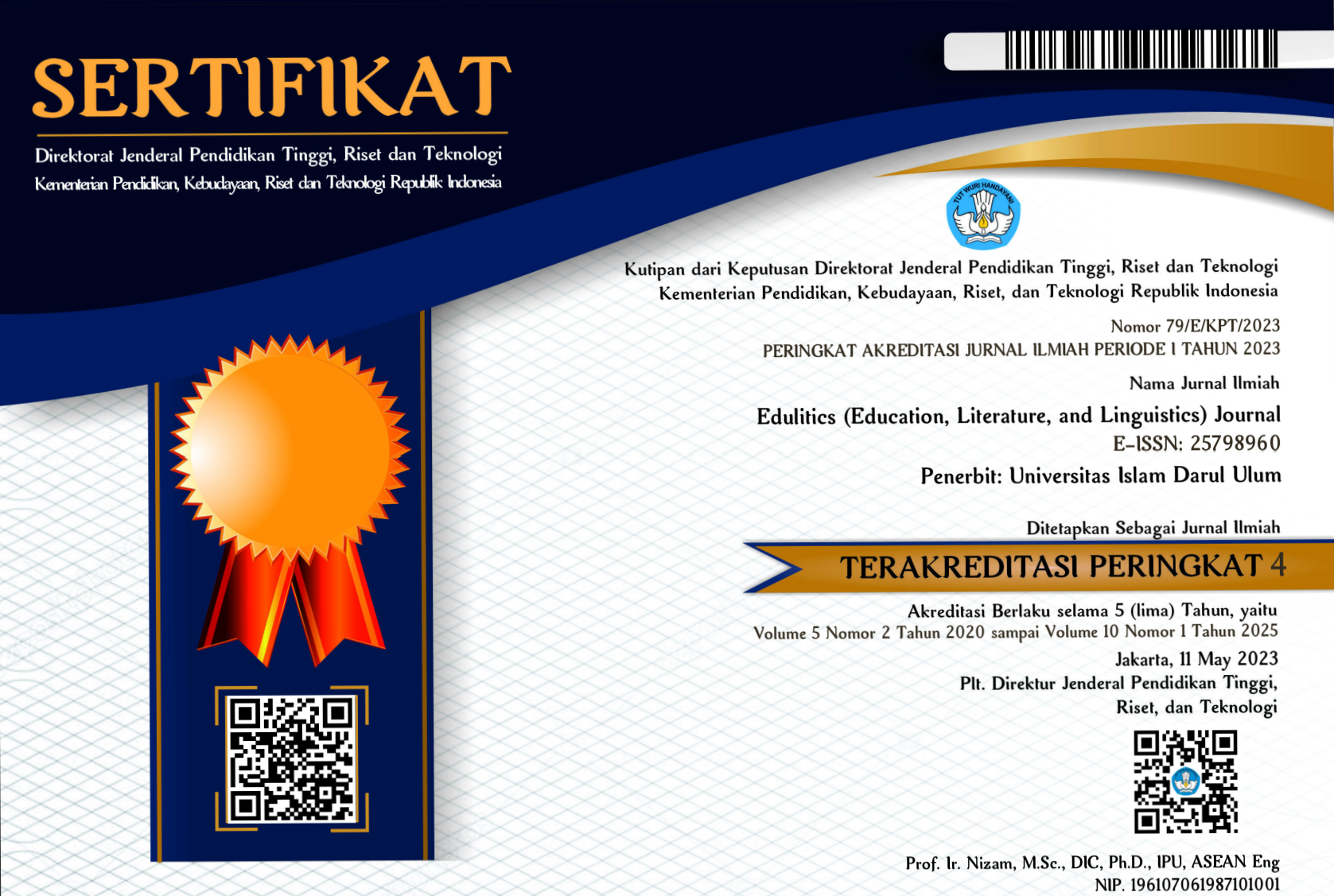The Use of Social Media as An English Learning Resource for The Students of Islamic University of Kadiri Kediri
Abstract
The aim of this research was to describe the kinds of social media that are mostly used and how students use social media as English learning resources. This research used a quantitative descriptive method with the data collection technique of a survey and simple random sampling technique. The subjects of research were all semesters in class A, Faculty of English Education, students of the Islamic University of Kadiri Kediri. The result of statistical calculations showed that YouTube was the social media platform that students used the most frequently as a resource for learning English, with 91.9% of students admitting to utilizing the platform to get better at listening. Next, according to 81.8% of students, they utilized YouTube to hone their speaking abilities. Additionally, 79.8% of students claimed to have used YouTube to advance their reading comprehension, and 77.8% claimed to have used it to advance their English writing abilities. The majority of students (37.97%) in the English Education faculty chose watching English videos as a resource for learning the language. Then, 32.49% of students said that an effective way to study English was to follow an English learning account. Furthermore, 29.54% of students claimed that speaking with native speakers in person was a useful way to learn English. Based on this research, it can be stated that the research that has been carried out has obtained positive results in accordance with existing theory and has benefits for the faculty, students, readers, and future researchers to increase insight in choosing the use of social media that can be used as an English learning resource. Thus, it can be concluded that social media YouTube can be a useful and effective tool for students to learn English.
Downloads
References
Arikunto, S. (2010). Prosedur penelitian pendekatan praktik edisi revisi VI. Rineka Cipta.
Asmaya, F. (2015). Pengaruh penggunaan media sosial facebook terhadap perilaku prososial remaja di kenagarian koto Bangun. Jurnal Online Mahasiswa (JOM) Bidang Ilmu Sosial Dan Ilmu Politik, 2(2), 1–15.
Ayuningtyas, P. (2018). Whatsapp: Learning on the go. Metathesis: Journal of English Language, Literature, and Teaching, 2(2), 159. https://doi.org/10.31002/metathesis.v2i2.629
Azzaakiyyah, H. K. (2023). The Impact of Social Media Use on Social Interaction in Contemporary Society. Technology and Society Perspectives (TACIT), 1(1), 1–9. https://doi.org/10.61100/tacit.v1i1.33
Bada, S. O., & Olusegun, S. (2015). Constructivism learning theory: A paradigm for teaching and learning. Journal of Research & Method in Education, 5(6), 66–70.
Batee, M. M. (2019). Pengaruh Media Sosial Terhadap Keputusan Pembelian Di Toko Kaos Nias Gunungsitoli. Jesya (Jurnal Ekonomi & Ekonomi Syariah), 2(2), 313–324. https://doi.org/10.36778/jesya.v2i2.108
DataReportal. (2023). Digital 2023: Global Overview Report. DataReportal. https://datareportal.com/reports/digital-2023-global-overview-report
Fatmawati, L., Sofeny, D., & Zahro, S. K. (2021). Students’ Attitudes Toward The Transformation of Online to Offline Learning in EFL Classroom. IJECA (International Journal of Education and Curriculum Application), 4(3), 264-272.
Handayani, R. D., Syafei, M., & Utari, A. R. P. (2020). The use of social media for learning English. Prominent Journal, 3(2), 313–321.
Jay, L. (2022). The disciplinary and critical divide in social studies teacher education research: A review of the literature from 2009–2019. Theory & Research in Social Education, 50(3), 339–374. https://doi.org/10.1080/00933104.2022.2077156
Kabilan, M. K., Annamalai, N., & Chuah, K.-M. (2023). Practices, purposes and challenges in integrating gamification using technology: A mixed-methods study on university academics. Education and Information Technologies, 28(11), 14249–14281. https://doi.org/10.1007/s10639-023-11723-7
Kemendikbud. (2023). Kontribusi Pengembangan Teknologi di Era Pendidikan Abad 21. Kementerian Pendidikan, Kebudayaan, Riset Dan Teknologi Direktorat Jenderal Guru Dan Tenaga Kependidikan. Accessed on 18 February 2024. https://ppg.kemdikbud.go.id/news/kontribusi-pengembangan-teknologi-di-era-pendidikan-abad-21
Lipschultz, J. H. (2020). Social Media Communication: Concepts, Practices, Data, Law and Ethics (3rd ed.). Routledge. https://doi.org/10.4324/9780429202834
Murtado, D., Hita, I. P. A. D., Chusumastuti, D., Nuridah, S., Ma’mun, A. H., & Yahya, M. D. (2023). Optimalisasi Pemanfaatan Media Pembelajaran Online Sebagai Upaya Meningkatkan Hasil Belajar Siswa di Sekolah Menengah Atas. Journal on Education, 6(1), 35–47. https://doi.org/10.31004/joe.v6i1.2911
Purwanto, A., Fahmi, K., & Cahyono, Y. (2023). The Benefits of Using Social Media in the Learning Process of Students in the Digital Literacy Era and the Education 4.0 Era. 02.
Rasyidah, D. S. (2017). Pengaruh Penggunaan Media Sosial dan Jenis-jenis Media Sosial terhadap Intensitas Belajar PAI Siswa Kelas VIII DI SMP N 3 Karangdowo Klaten Tahun Pelajaran 2016/2017. Jurnal Skripsi Tidak Diterbitkan. Yogyakarta: Fakultas Ilmu Tarbiyah Dan Keguruan.
Rennie, F., & Morrison, T. (2013). E-learning and social networking handbook: Resources for higher education. Routledge.
Sabah, N. M. (2023). The impact of social media-based collaborative learning environments on students’ use outcomes in higher education. International Journal of Human–Computer Interaction, 39(3), 667–689.
Savitri, R. D., & Sukoyo, J. (2023). The Use of TikTok as a Learning Resource for Dialogue Text in Junior High School. AL-ISHLAH: Jurnal Pendidikan, 15(3), 3631–3638.
Sugiyono. (2017). Metode penelitian kuantitatif, kualitatif, dan R&D (cet. 26.). Bandung: Alfabeta. https://inlislite.uin-suska.ac.id/opac/detail-opac?id=27259
Sujarwo, Santi, F. U., & Tristanti. (2018). Pengelolaan Sumber Belajar Masyarakat. Universitas Negeri Yogyakarta. https://staffnew.uny.ac.id/upload/198703282014042002/pendidikan/buku%20pengelolaan%20sumber%20belajar%202018.pdf
Sumerta, I. K., Redianingsih, N. K., Pranawa, I. M. B., & Indahyani, D. N. T. (2020). Pengaruh Tingkat Penggunaan Media Sosial Dan Motivasi Terhadap Minat Berwirausaha Pada Mahasiswa Program Studi Manajeman Perguruan Tinggi Di Kota Denpasar. E-Jurnal Ekonomi Dan Bisnis Universitas Udayana, 627. https://doi.org/10.24843/EEB.2020.v09.i07.p03
Thaariq, Z. Z. A. (2020). The use of social media as learning resources to support the new normal. Teknodika, 18(2), 80–93.
Thapliyal, K., Thapliyal, M., & Thapliyal, D. (2024). Social Media and Health Communication: A Review of Advantages, Challenges, and Best Practices. Emerging Technologies for Health Literacy and Medical Practice, 364–384.
Tzur, S., Katz, A., & Davidovitch, N. (2023). The Impact of Social Networks on Student Motivation and Achievement. In Discourses of Globalisation, Multiculturalism and Cultural Identity (pp. 119–140). Springer.
Zahro, S. K., & Tasaufy, F. S. (2019). The Development of Educational Youtube Videos-Based Instructional Material for Speaking for Beginner Course. Indonesian of English Teaching, IJET, 8(2).

This work is licensed under a Creative Commons Attribution-ShareAlike 4.0 International License.
Authors retain copyright and grant the journal the right of first publication with the work simultaneously licensed under a Creative Commons Attribution-ShareAlike 4.0 International License that allows others to share the work with an acknowledgment of the work's authorship and initial publication in this journal.
Authors are able to enter into separate, additional contractual arrangements for the non-exclusive distribution of the journal's published version of the work (e.g., post it to an institutional repository or publish it in a book), with an acknowledgment of its initial publication in this journal.
Authors are permitted and encouraged to post their work online (e.g., in institutional repositories or on their website) before and during the submission process, as it can lead to productive exchanges and earlier and greater citation of published work.







_(1).png)


